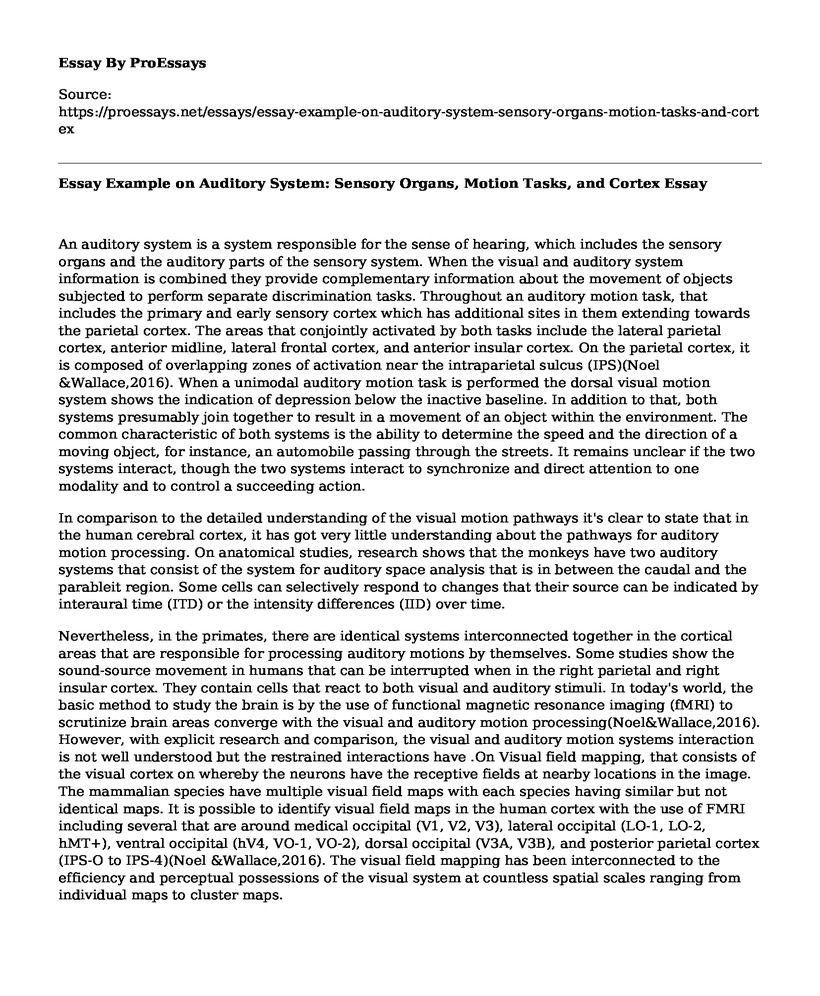An auditory system is a system responsible for the sense of hearing, which includes the sensory organs and the auditory parts of the sensory system. When the visual and auditory system information is combined they provide complementary information about the movement of objects subjected to perform separate discrimination tasks. Throughout an auditory motion task, that includes the primary and early sensory cortex which has additional sites in them extending towards the parietal cortex. The areas that conjointly activated by both tasks include the lateral parietal cortex, anterior midline, lateral frontal cortex, and anterior insular cortex. On the parietal cortex, it is composed of overlapping zones of activation near the intraparietal sulcus (IPS)(Noel &Wallace,2016). When a unimodal auditory motion task is performed the dorsal visual motion system shows the indication of depression below the inactive baseline. In addition to that, both systems presumably join together to result in a movement of an object within the environment. The common characteristic of both systems is the ability to determine the speed and the direction of a moving object, for instance, an automobile passing through the streets. It remains unclear if the two systems interact, though the two systems interact to synchronize and direct attention to one modality and to control a succeeding action.
In comparison to the detailed understanding of the visual motion pathways it's clear to state that in the human cerebral cortex, it has got very little understanding about the pathways for auditory motion processing. On anatomical studies, research shows that the monkeys have two auditory systems that consist of the system for auditory space analysis that is in between the caudal and the parableit region. Some cells can selectively respond to changes that their source can be indicated by interaural time (ITD) or the intensity differences (IID) over time.
Nevertheless, in the primates, there are identical systems interconnected together in the cortical areas that are responsible for processing auditory motions by themselves. Some studies show the sound-source movement in humans that can be interrupted when in the right parietal and right insular cortex. They contain cells that react to both visual and auditory stimuli. In today's world, the basic method to study the brain is by the use of functional magnetic resonance imaging (fMRI) to scrutinize brain areas converge with the visual and auditory motion processing(Noel&Wallace,2016). However, with explicit research and comparison, the visual and auditory motion systems interaction is not well understood but the restrained interactions have .On Visual field mapping, that consists of the visual cortex on whereby the neurons have the receptive fields at nearby locations in the image. The mammalian species have multiple visual field maps with each species having similar but not identical maps. It is possible to identify visual field maps in the human cortex with the use of FMRI including several that are around medical occipital (V1, V2, V3), lateral occipital (LO-1, LO-2, hMT+), ventral occipital (hV4, VO-1, VO-2), dorsal occipital (V3A, V3B), and posterior parietal cortex (IPS-O to IPS-4)(Noel &Wallace,2016). The visual field mapping has been interconnected to the efficiency and perceptual possessions of the visual system at countless spatial scales ranging from individual maps to cluster maps.
Conclusion
In conclusion, the issue that is been represented revolves around the investigations and the relationship between structure and function in the visual and auditory systems. The outcomes designate that the visual and auditory motion processing takes most of the conjoint serious cortical offered and the environment of the auditory.
Reference
Noel, J. P., & Wallace, M. (2016). Relative contributions of visual and auditory spatial representations to tactile localization. Neuropsychologia, 82, 84-90. https://www.sciencedirect.com/science/article/pii/S0028393216300057
Cite this page
Essay Example on Auditory System: Sensory Organs, Motion Tasks, and Cortex. (2023, May 08). Retrieved from https://proessays.net/essays/essay-example-on-auditory-system-sensory-organs-motion-tasks-and-cortex
If you are the original author of this essay and no longer wish to have it published on the ProEssays website, please click below to request its removal:
- Personal Essay Example: My Views on Zoos
- Whether My Sense of Smell Affect My Sense of Taste? - Essay Sample
- Paramedic Retrospective Analysis
- 400 Million Yr Old Great White Sharks: Nature's Apex Predators - Research Paper
- An Otter's Symbolism: Power, Peace, Family & More - Research Paper
- Captive Tigers: An Unsustainable Population in the US - Research Paper
- Animal Testing: Pros & Cons of a Controversial Practice - Essay Sample







